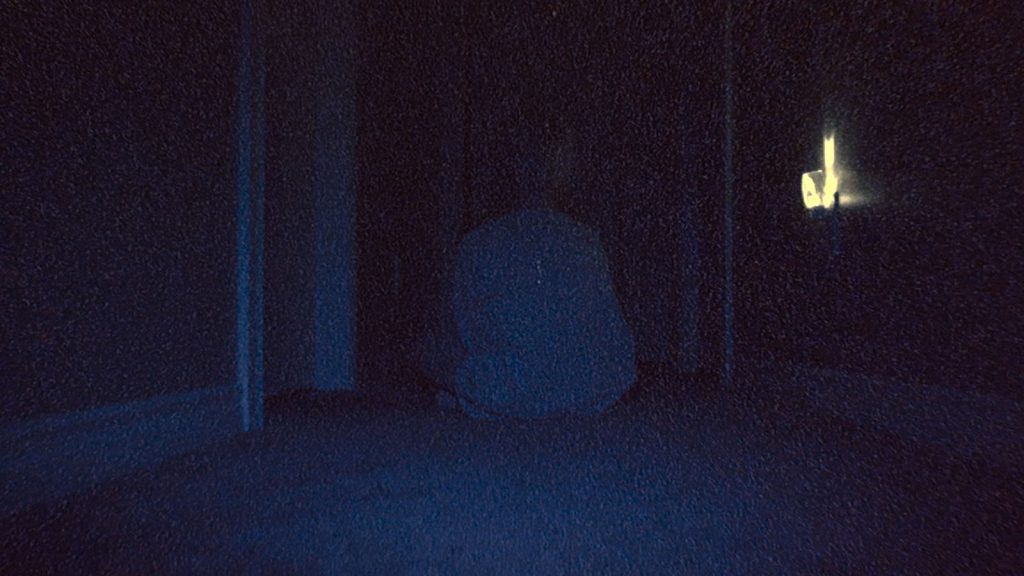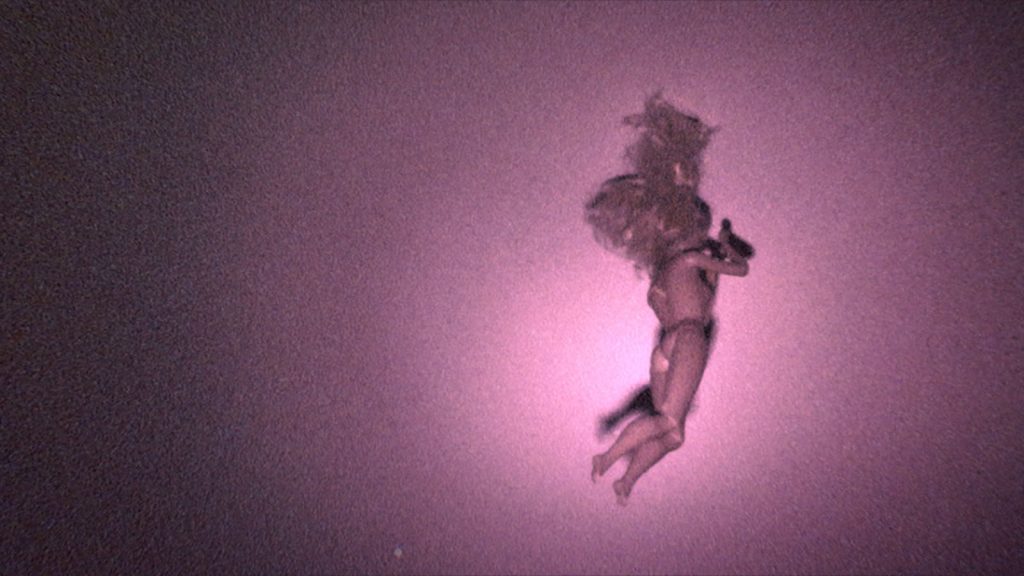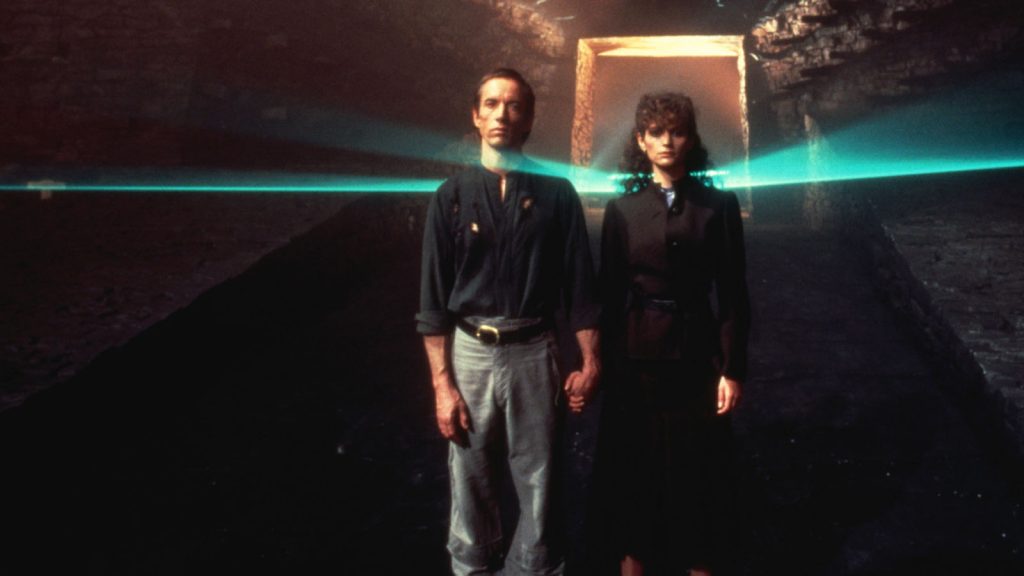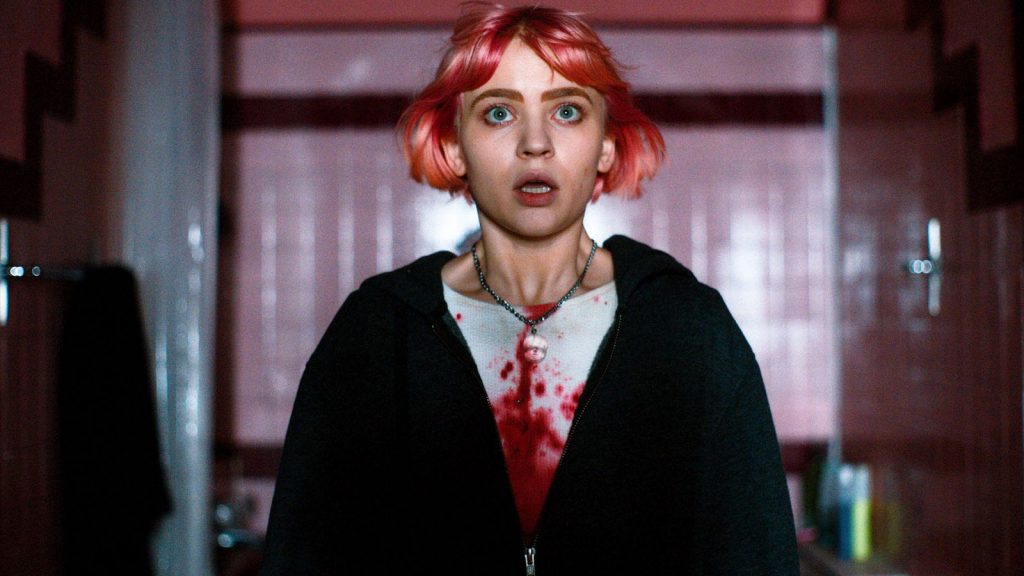
We go to the movies to see ghosts, whether they be the likenesses of long-gone actors, objects, or edifices, or the suggestion of specters imprinted in the gloom of otherwise benign images. Photography beguiles us with the promise of representing reality, but from the start, it accommodated the phantasmagoric. That moving images were made for ghosts is something Canadian writer-director Kyle Edward Ball is all too aware of. Skinamarink, his feature debut, seems to owe its existence to the desire to conjure phantoms within cinematic murk: the digitally imposed faux-cheapo-camcorder gauze that permeates the film is so thick it often resembles the heat shimmer over sunbaked tarmac, rendering every aggressively chiaroscuro scene so fuzzy, blobby, and dusty with video grain and surface noise that there’s little on-screen that doesn’t resemble a ghost. One hesitates to call Skinamarink a ghost story, however, for the simple reason that there’s little story to speak of.
The protagonists are child siblings left alone for the night. Except they’re not alone: Mom unexpectedly turns up, but her appearance is not consoling. Other forces make their presence known. Eventually, some spooky shit transpires. A toilet disappears and reappears. Legos move of their own volition. Is that chair on the ceiling? Mostly, these kids don’t seem particularly fazed—perhaps they’ve seen it all in movies. Over Skinamarink’s duration, Ball slowly stacks the tropes: there are inky, ominous cartoons from the 1930s and old, clunky toys; a TV screen eerily illuminates a room; there are apparitions who won’t show their faces, but who, in distorted mumbles, offer hoary imperatives to look under the bed. The spare dialogue—half of it inaudible, some of it subtitled—is loaded with such generic portent, which at its best is quite funny, the comedy enhanced by the paucity of activity: so much of the film is taken up with static shots of rugs, doors, unadorned walls, and a half-eaten bowl of Mini-Wheats. Dead air dominates. When feet enter the frame, it’s a whole thing. At one point during the screening I attended, an audience member suddenly made a loud shushing sound, which prompted much laughter because there was no one to shush: not a peep could be heard in the audience or emerging from the speakers. And there wasn’t much to look at, either.

Perhaps inspired by 2007’s Paranormal Activity, in which exceedingly anodyne environs provide a clever, counterintuitive setting for a ghost story and a foolproof foundation for jump scares, Skinamarink’s single, all-interiors location is a cookie-cutter domicile, a sort of anti–show house with its macaroni carpets, flimsy doors, and cheap hardware on prolonged display. (Ball shot the film in his childhood home in Edmonton, Alberta. I was raised in Alberta and lived in Edmonton for eight years. Improbable as this may sound, without knowing that it was in fact made there, I spent the entire film thinking that the utterly unremarkable house looked depressingly Albertan.) Combined with the color-bled imagery and snap-crackle-pop soundtrack, the setting might cause one to wonder if Ball aspired to craft the shittiest-looking movie ever made. He presents the lo-fi aesthetic as a fetish object, but unlike the early-cinema fever dreams of Ball’s fellow prairie boy Guy Maddin, this fetish is not accompanied by formal rigor or fresh ideas.
A firm commitment to genre and a premise constructed from overfamiliar elements can sometimes serve as a springboard for surprising detours, or as an opportunity to delve so deep into detail that a film transcends its clichés. I suspect Ball is invested in cliché: it, too, can be a fetish. While many otherwise promising horror films can get bogged down in internal mythologies (Hereditary, Insidious, The Conjuring), Skinamarink arguably suffers from the opposite problem: its creator doesn’t convey the slightest interest in narrative or character development. Perhaps it’s best to regard the result not as a horror movie, but rather as an essay on horror movies. The film’s third act features several highly amusing moments that will frighten no one, though they might make you reflect on the ways that horror movies work on us—especially those we see as small children, in big, empty, boring houses on impossibly dark nights, when every shadow and every noise could be mistaken for the rumblings of the dead.

is a freelance critic and playwright.
From its opening image of ocean waves stuttering slowly behind a sheet of steely rain to its final vista of human detritus turned into cosmic junk, Nr. 10 seems...
BY JOSÉ TEODORO | September 12, 2022
It’s both a mystery and a shame that Joel Anderson has directed only one feature, emerging out of nowhere to unleash a film that has slowly gained cult status, only to pretty much disappear...
BY RUFUS DE RHAM | October 31, 2022
It is springtime 1973, and the days are bright on a small island off the coast of Cornwall. A horticulturist (Mary Woodvine), known only as the volunteer, is the island’s sole inhabitant. Or is she?
BY JOSÉ TEODORO | March 28, 2023

This pre-Code offering packs a lot of story into its typically brisk running time, with several plot threads weaving together a (not always successful) tapestry of spooky and criminal doings.
READ MORE >
BY ANN OLSSON | Month 00, 2021

In what could be the fastest-resulting rape revenge movie, a drunken lout brutally forces himself on Ida, the young woman who doesn't return his affections, during a party over Labor Day.
READ MORE >
BY LAURA KERN | Month 00, 2021

Beast is a lot of movies in one package - fractured fairy tale, belated-coming-of-age story, psychological drama, regional horror film - but above all it's a calling card for its leading lady, Jessie Buckley.
READ MORE >
BY LAURA KERN | Month 00, 2021